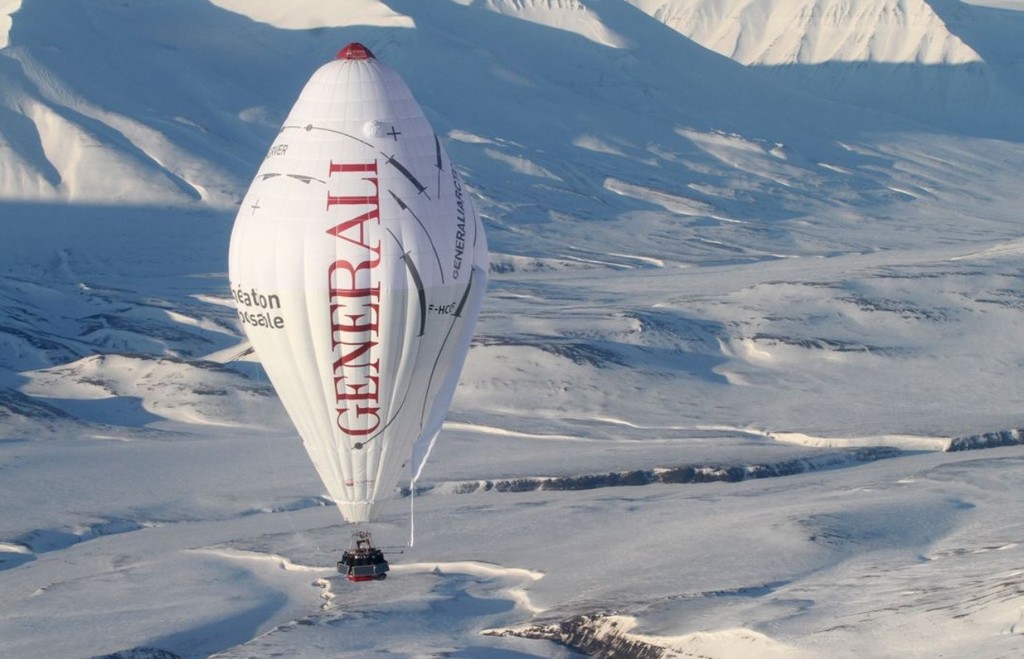Jean-Louis Etienne - Heading Towards the North Pole
by Coralie Jugan on 7 Apr 2010

Jean-Louis Etienne setting out on Monday 5th April 2010. Armelle Quéré
After setting out yesterday morning from Longyearbyen (Spitsbergen), aboard the Generali Arctic Observer balloon, Jean-Louis Etienne is currently heading due north towards the North Pole, which he may well reach by Wednesday evening. He has now cleared the mountains and glaciers in Spitsbergen, and is quietly flying over the Arctic Ocean at a height of around 300 meters.
Hardly having time to get over the excitement of the start, Etienne began his crossing of the North Pole by balloon, with a flight over the mountains and all the risks that entails. 'I flew along the mountain sides and had a few scary moments, suddenly seeing dark rock faces slipping by,' explained Etienne during his first link-up with Flight HQ at Generali’s Paris premises. 'Flying over mountains is not that easy. I had to remain low enough to find my way from one valley to another and at the same time stay as close as I could to the trajectory that Christophe Houver (flight coordinator) gave to me. At one point I found myself flying in foggy conditions, as the wind was in the right direction in the mist. Piloting the balloon in misty conditions is a bit stressful, especially with the mountains around!'
Fortunately, Etienne was also able to enjoy some magic moments, looking at the wonderful sights around him. 'Yesterday was quite exceptional. Flying alone, suspended in the air in the middle of the mountains and glaciers in Spitsbergen, on such a fine day is a unique experience. At the moment, I’m bouncing around on the edge of the mist at an altitude of around 300 meters. The gondola is just touching the edge of the mist, while the balloon is in the sunshine. It’s costing me nothing to travel! I’m not using any helium or gas, which is good, as last night I had to use a lot of gas to compensate for the ice which had built up on the balloon, making the rozière heavier.'
230 miles covered
On Tuesday at 1500 hrs, since starting out Etienne had covered 370 km (around 230 miles) heading north-eastwards. 'During the first twelve hours, the balloon tended to move eastwards rather than towards the north,' explained Luc Trullemans, the weather expert and router for the expedition. 'With the hurried take-off yesterday, we had to take the balloon up to an altitude of 600 meters to reach the southerly wind, which will take him towards the Pole. Today, we told him to go back down to 200-300 meters as that is where the strongest and most favorable winds can be found. This afternoon, he is following a perfect flight path, heading due north at 23 km/h (14 mph).' At that speed, according to Trullemans’s forecasts, Etienne may well reach the North Pole by tomorrow evening.
In his confined space, the doctor-explorer is getting into the swing of the voyage and quickly getting used to his new environment. 'It’s -12°C outside and 15°C inside without the heating. The gondola is extremely well built, using insulating materials. It is small and the sun comes in the six little portholes in turn, as the balloon is spinning around. It is very comfortable, and everything is within reach. I managed to get a total of two to three hours of sleep last night, in short bursts. I’m really enjoying being where I am. I’m imagining what the sea of clouds ahead of me is like as I enter it.'
Once over the mountains, Etienne was able to put out his sensors to take some scientific measurements. He has started collecting information on the CO2, the magnetic field, the tropospheric ozone and the suspended particles. These tests will continue throughout this first solo balloon crossing of the Arctic Ocean.
About the Generali Arctic Observer expedition
The explorer Jean-Louis Etienne set out on Monday 5th April on the Generali Arctic Observer expedition to carry out the first flight over the North Pole in a balloon. This is the third and final act of the trilogy of solo expeditions to the North Pole. This scientific expedition will enable measurements to be taken concerning the earth’s magnetic field, the CO2 in the atmosphere, the tropospheric ozone and suspended particles. The expedition is backed by the Generali insurance company.
If you want to link to this article then please use this URL: www.sail-world.com/68251